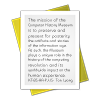Description
Iain S. Duff explores the whole of his career to date. Duff grew up in Glasgow, attending The High School before earning a first class degree in Mathematics and Natural Philosophy from the University of Glasgow in 1969. He discusses the mathematical curriculum there, and recounts his early computing experiences as a summer fellow with IBM. Duff won a Carnegie Fellowship for postgraduate work at Oxford, culminating in a D.Phil. conferred in 1972. At Oxford he worked with the numerical analysis group and wrote his thesis on the analysis of sparse systems under the direction of Leslie Fox. While working toward his degree, Duff was already collaborating with Alan Curtis, Michael Powell, and John Reid at the nearby AERE Harwell nuclear power research center. His interest in sparse matrices was cemented by a 1971 visit to IBM’s Yorktown Heights laboratory for a conference, where he first met colleagues such as Alan George, Ralph Willoughby and Fred Gustavson. In 1972, Duff went to the United States on a Harkness postdoctoral fellowship, spending time at SUNY Stony Brook with Reggie Tewarson and Stanford, where he got to know Gene Golub. In 1973 he became a computing lecturer at Newcastle University, before returning to Harwell as a researcher in 1975. He continued to work on sparse matrix methods, establishing himself as a leading researcher in the area, through pioneering work with John Reid on multi-frontal methods, a series of widely read review articles, and an influential book written in collaboration with Reid and Al Erisman. Duff rose within Harwell, becoming leader of its numerical analysis group in 1986. He explores in detail the development and composition of this group, paying particular attention to the Harwell Subroutine Library, a collection of numerical subroutines developed within Harwell from the mid-1960s on and widely distributed to other sites. Duff explains its history, evolution, areas of strength, sources of routines, documentation methods, distribution practices, relationship to the NAG library, and attempts at commercial exploitation. In 1990 Duff led his group from Harwell to the nearby Rutherford Appleton Laboratory, as government cuts and shifts in priorities threatened its future at Harwell. Since 1987 Duff has also led the Parallel Algorithms group at CERFACS in Toulouse, and discusses the origins of CERFACS, the composition and functioning of his group, and its involvement in the MUMPS and PARASOL projects to create parallel multifrontal solvers for sparse systems. Duff worked on various forms of BLAS, including contributions to the Level 3 BLAS specifications (with Jack Dongarra and others) and development of the Sparse BLAS standard (with Mike Heroux and Roldan Pozo). Duff also reviews his roles in a number of societies, including SIAM (as a Council member and Trustee), IMA (including editorship of its Journal of Numerical Analysis), LMS, ACM SIGNUM and SMAI, and his work as a consultant on supercomputing issues to the governments of countries including Malaysia, Sweden, Germany and the USA.
Date
2005-08-30; 2005-08-31
Contributor
|
Duff, Iain S., Interviewee
|
|
Haigh, Thomas, Interviewer
|
Publisher
SIAM and U.S. Department of Energy
Place of Publication
East Hagbourne, United Kingdom; Chilton, United Kingdom
Extent
91 p.
Format
PDF
Copyright Holder
Computer History Museum
Category
Transcription
Subject
Applied mathematics; International Business Machines Corporation (IBM); Numerical analysis; Sparse matrix; CERFACS; Basic Linear Algebra Subprograms (BLAS); Sparse BLAS
Collection Title
Society for Industrial and Applied Mathematics (SIAM) oral history collection
Credit
Gift of SIAM and the US Department of Energy


